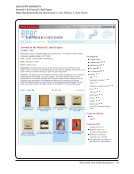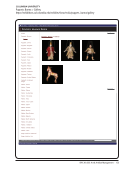40 · Survey Results: Survey Questions and Responses
particular collection or acquisition, we plan for processing and cataloging by assessing the “Use, Value, and Viability.”
We have at least a summary description for each collection, increasingly supplemented by a container list that outlines
broad contents or provides an index. Material that is inherently fragile or difficult to handle safely is likely to receive
item-level listing or at least item-level tracking through a unique identification number, e.g., original drawings and
photographic negatives.
Like our art works, some artifacts have large amounts of detailed information that comes with them (especially
narratives) for which there is no room to efficiently input or display. Also need a system that allows managing and easy
linking to related audiovisual materials like photos, and bibliographic records.
My answer here is the same as for art objects—the variety and types of tools that have been available to us has evolved
over time. Choices on which system to use involve the best choice at the time.
Our library hopes to adopt Archivists’ Toolkit in the near future to improve our efforts at creating detailed finding aids.
Same as for art objects. We don’t differentiate between art and artifacts in treatment.
The museum collections management system (iO/TMS) is the primary tool used to describe and manage artifact
collections. In some libraries, artifacts such as books, photographs, or AV materials that were originally acquired by
the museum are often transferred to the libraries’ archives or AV collection based on their anticipated use. By the
same token, oversized or framed archival materials are often transferred from the archives to the museum collection to
support optimal care and access.
We haven’t been systematic in the past, but we are working a standard protocol for artifacts.
28. How do you display information about the artifacts to the public? Check all that apply. N=63
Library catalog 38 60%
Static website or other documents available on the web
(e.g., finding aid, inventory list, etc.) 33 52%
Web-accessible front end to archival management system 18 29%
Web-accessible front end to internal database 11 18%
Onsite access to internal database 6 10%
Web-accessible front end to museum collection management system 3 5%
No information is displayed to the public 13 21%
Other method 17 27%
Please specify the other method.
Catalog records only for those that remained in archival collection. Otherwise only onsite access to paper records.
CONTENTdm
particular collection or acquisition, we plan for processing and cataloging by assessing the “Use, Value, and Viability.”
We have at least a summary description for each collection, increasingly supplemented by a container list that outlines
broad contents or provides an index. Material that is inherently fragile or difficult to handle safely is likely to receive
item-level listing or at least item-level tracking through a unique identification number, e.g., original drawings and
photographic negatives.
Like our art works, some artifacts have large amounts of detailed information that comes with them (especially
narratives) for which there is no room to efficiently input or display. Also need a system that allows managing and easy
linking to related audiovisual materials like photos, and bibliographic records.
My answer here is the same as for art objects—the variety and types of tools that have been available to us has evolved
over time. Choices on which system to use involve the best choice at the time.
Our library hopes to adopt Archivists’ Toolkit in the near future to improve our efforts at creating detailed finding aids.
Same as for art objects. We don’t differentiate between art and artifacts in treatment.
The museum collections management system (iO/TMS) is the primary tool used to describe and manage artifact
collections. In some libraries, artifacts such as books, photographs, or AV materials that were originally acquired by
the museum are often transferred to the libraries’ archives or AV collection based on their anticipated use. By the
same token, oversized or framed archival materials are often transferred from the archives to the museum collection to
support optimal care and access.
We haven’t been systematic in the past, but we are working a standard protocol for artifacts.
28. How do you display information about the artifacts to the public? Check all that apply. N=63
Library catalog 38 60%
Static website or other documents available on the web
(e.g., finding aid, inventory list, etc.) 33 52%
Web-accessible front end to archival management system 18 29%
Web-accessible front end to internal database 11 18%
Onsite access to internal database 6 10%
Web-accessible front end to museum collection management system 3 5%
No information is displayed to the public 13 21%
Other method 17 27%
Please specify the other method.
Catalog records only for those that remained in archival collection. Otherwise only onsite access to paper records.
CONTENTdm


















































































































































































